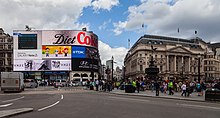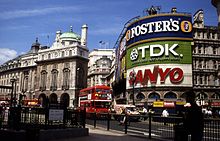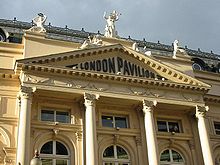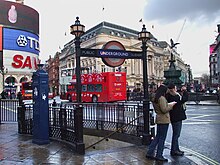Piccadilly Circus
| Piccadilly Circus | |
|---|---|
| Place in London | |
 Piccadilly Circus |
|
| Basic data | |
| place | London |
| District | City of Westminster , West End , Soho |
| Created | 1819 |
| Newly designed | 1924-1932, 1962-1963, 1984-1986 |
| Confluent streets | Regent St , Shaftesbury Avenue , Lower Regent Street , Glashouse Street , Coventry St , Piccadilly , Haymarket |
| Buildings | London Pavilion , Criterion Theater , Shaftesbury Memorial Fountain |
| use | |
| User groups | Foot traffic , car traffic , local public transport |
Piccadilly Circus is an intersection and public square in the West End of London . It was completed in 1819 to connect Regent Street to Piccadilly . In the architectural sense, a “circus” is a round, public area at a street crossing or a kind of roundabout, but without a built center island. Piccadilly Circus has not been recognizable as such since 1886. Today it connects Shaftesbury Avenue , Haymarket , Coventry Street (towards Leicester Square ), Regent Street and Lower Regent Street , Piccadilly and a small side street, Glasshouse Street. The circus is close to numerous shopping and entertainment areas. The fact that it is a hub of some of the main streets in London makes it a lively hangout.
During the time of colonization and the great “British Empire”, Piccadilly Circus was often referred to as the “center of the world”.
history
1811-1924
In 1811, the Prince Regent, who would later become King George IV, wanted a boulevard that would begin in St James's and lead to Regent's Park . He commissioned the most famous architect of the time, John Nash , to fulfill this wish. After eight years of construction, the masterpiece was completed in 1819. The Regent Street and Piccadilly Circus (to 1886 even "Regent Circus South") and Oxford Circus (to 1886 even "Regent Circus North") and the Waterloo Place were created. However, Piccadilly Circus was just a simple intersection at the confluence of Piccadilly and Regent Street, where the house facades were concave, so that they formed a circle (circus). Even then, Piccadilly Circus was a very busy hub. However, the closed development of the intersection was soon broken open. In 1886, in memory of the 7th Earl of Shaftesbury, a large road linking the slums from Soho to north London to Bloomsbury was built, which is now known as Shaftesbury Avenue . Numerous houses had to be demolished for this construction project, including a block directly on Piccadilly Circus, which was part of the four quadrants that formed the circus up to that point. This is how the triangular layout of the entire intersection area that can still be found today was created. The London Pavilion was opened together with the new intersection, as the previous building on Shaftesbury Avenue had to give way. The three of the original four quadrants, as well as the Swan & Edgar department store and the Criterion Theater , remained after the surrounding buildings were demolished.
Shaftesbury Memorial Fountain
A memorial street for the Earl was far too little for the citizens of London and they decided to raise funds to erect a memorial. In 1893 the Shaftesbury Memorial Fountain , now known as the Eros Fountain, was inaugurated. However, the winged figure on the top should not represent Eros , but the angel of Christian charity. The prudish Victorians were not very enthusiastic about the almost naked aluminum figure, mocked them and mocked Sir Alfred Gilbert , the builder of the monument. It was the first monument in London to be cast entirely from aluminum. The fountain was built on four low steps and was surrounded by a small, low wall with a plaque commemorating the Earl. The whole ensemble was in the shape of an octagon. At the beginning of 1895, the wall surrounding the fountain was removed for aesthetic reasons. This is how one of the most popular meeting places in London came about. Flower girls and shoe shiners sat down on the steps and could be seen until the 1940s. Drinking vessels that were attached to the fountain basins with chains were removed in 1899 for reasons of hygiene.
Redesign 1924–1932
In 1924, when the majority of the buildings on the west and south sides of the intersection, at the entrance to Piccadilly and Regent Street, became royal property, it was decided to redesign the entire intersection. The old buildings from the Regency period, with their relatively unadorned, white facades and the simulated Ionic or Doric columns, were completely demolished. The building was found to be out of date and representative. They were also too small to meet the growing demands of business owners. Furthermore, one criticized Nash's sloppy construction. The old buildings have been replaced by buildings that are almost twice as high as their predecessors, but in a different architectural form ( eclecticism ) and without the quadrants that form a circus. Generous business premises found space in it; large bosses were used instead of stucco for embellishment and instead of the small windows, large, mostly two-story, arched window fronts were created. Furthermore, arched arcades, high chimneys, domes and figure decorations were used for embellishment. The main construction work was completed in 1928. Only the London Pavilion and the Victorian Criterion Theater opposite survived this radical cure.
From 1924 to 1932 the Erosbrunnen was also removed from the intersection. The fountain basins were renovated and the angel figure was meanwhile placed in Victoria Embankment Gardens near the Parliament building. In the meantime, a new underground pedestrian deck with kiosks and a ticket counter has been built and the underground station underneath has been enlarged and modernized; In December 1928, construction work was also completed here. After all the renovation work, the fountain was rebuilt on the circus at the end of 1932. A plateau of five more steps was added to it and it was set up again in the middle of the intersection. Now because of the new steps it was 1.03 meters higher than before. Adapted to the octagonal ground plan of the fountain, a narrow sidewalk was built around the steps and four large street lamps were added. In 1937 the traffic control was changed to traffic light control by the police officers who were originally at every entrance to the circus. The subway's ventilation system, which was on a small traffic island next to the monument, was also removed.
In order to cope with the increasing traffic, a roundabout system was introduced at the intersection as early as 1926, which was manifested in 1934 by the first marking of lanes. The use of lane markings in the form of stop lines and direction arrows was tried out for the first time as early as 1930 and was later introduced.
World War II and 1950s

During the war there were a few changes or protective measures in Piccadilly Circus. In 1941 the angel figure was removed from the fountain and stored in a bunker in Egham. The well itself was covered with iron plates. The neon signs were turned off and not put back into operation until April 3, 1949. The lights of the street lamps were removed. The bases of the lanterns and traffic lights, as well as the curbs were painted black and white striped to make them more visible in the dark. In addition, the subway entrances were roofed over with small brick bunkers. During the air raids in September 1940, a crater was shot in nearby Regent Street and some buildings behind the circus were bombed. The force of the explosions shattered the panes of glass and some billboards in the square, which meant that the windows were covered with wooden panels until the end of the war. Only two years after the war, in June 1947, was the angel figure placed on the fountain again. In 1951, at the Festival of Britain, the fountain was turned on for the first time and its basins filled with water. In 1952, the last flower seller and the last shoe shiner left the place forever.
New planning in 1961 and 1973
In 1961, however, it was discovered that the whole ensemble was far too dangerous. Since the small square with the monument on it functioned as a roundabout, it was surrounded by heavy traffic day and night and was hardly accessible to the countless pedestrians. But they just ran over the busy intersection and often got caught between the buses and cars. There were no pedestrian lights or marked crossings at this time. In addition, traffic had increased so much over the past 30 years that there were almost always enormous congestion around the monument. Finally, the decision was made to abandon the roundabout and build a square that would adapt to the triangular shape of the intersection. For example, between 1961 and 1963, an almost triangular area around the memorial with barriers and pylons was built on a trial basis. After a positive result and the simplification and improvement of the traffic flow, the cordoned-off area was finally paved and opened in 1963. With it, a taxi stand or a bus stop for sightseeing buses was created directly at the fountain. Now the traffic could no longer completely drive around the monument and there was more space for pedestrians. However, this cut the connection between Shaftesbury Avenue and Piccadilly . Many buses now had to take a detour through nearby Jermyn Street . After protracted debates about the dismantling of the square, a compromise was found and in 1973 a narrow bus lane was built across the paved central island, thus breaking up the unity of the square. This initially ensured that the buses departed quickly.
Complete redesign from 1984
Another major structural change followed from 1984, which was not completed until the end of the decade. Since the whole area was too shabby, it was decided to have a complete overhaul. Every day there were big traffic jams and a few accidents at the intersection. It was found that the memorial stood in the way and that all traffic could only pass the intersection very slowly. As early as the 1970s, the city was presented with many building plans. Some provided for high-rise glass buildings with connecting walkways for pedestrians, others wanted to remove the monument completely and build a more traffic-friendly intersection. These plans were all rejected because the aim was to preserve the architectural character of the intersection. Finally, the London Pavilion was first extended . It received a low hipped roof made of slate, as well as a mezzanine floor and some Victorian groups of figures as decoration.
In the autumn of 1984, as in 1924, the fountain was removed from the intersection and restored by experts in Edinburgh, because the basins and the aluminum figure had been badly damaged by the fumes of the past 20 years. Meanwhile, the entire traffic routing at the intersection has been changed. The traffic island, which was built in 1963 and redesigned in 1973, including the bus stop and taxi stand, was removed, and with it the poorly planned traffic routing from narrow entrances, exits and passages. A logical and simple street layout was created with wider streets and wider sidewalks, as well as fewer stops with traffic lights.
The Shaftesbury Avenue was converted to one-way street and could now be used only as exit from the Circus.
The facades of the buildings on the western side of the intersection, in the direction of Piccadilly and Regent Street, were also cleaned because the once so famous London smog had blackened or darkened them over the years.
After its repair, the fountain was rebuilt in a completely new location, 40 feet further east from the center of the intersection, no longer standing in isolation on a traffic island, but enclosed in a paved area in front of the Criterion Theater, which is reserved exclusively for pedestrians. As a result, the thoroughfare in front of the Criterion Theater , the bus lane and the old bus stop on the square were abandoned. The square around the fountain was laid out in such a way that traffic had to pass it in a gentle arc. This makes the memorial much easier to access for the countless visitors, in contrast to the old design of the square, when the fountain was still isolated on the traffic island and there was hardly any access due to the barriers along the sidewalks and around the island. Another subway entrance was also created next to the monument, roughly level with the old bus stop. Piccadilly Circus was to be found until 2009.
2009 – today
At the beginning of the 21st century, Piccadilly Circus was to experience another major structural redesign. The traffic situation was discussed again. According to this, the one-way street system should be abandoned after about 40 years. The reason was the construction of a new bus lane along Shaftesbury Avenue. It should lead across the square and flow directly into Piccadilly. In addition, Haymarket and Lower Regent Street are to be redesigned into normal two-lane streets, thereby completely redesigning the square. The roundabout with the fountain from the 1950s will not be restored, but the space around the monument will be made smaller because the streets will be widened. New and modern street lights and the removal of the barriers along the sidewalks are planned. The construction work for the redesign started on August 19, 2009 and should be completed by the 2012 Olympic Games. The renovation costs have been estimated at around £ 40 million.
The main redesign of the square has now been completed. The new bus lane along Shaftesbury Avenue has opened. It now flows into the Circus and is only separated from oncoming traffic in the middle of the intersection by a narrow traffic island. The old traffic island was also dismantled here to make it easier to drive into Piccadilly. In addition to the new bus lane, new pedestrian crossings were built; one in front of the London Pavilion and one between the memorial and the former Virgin superstore. By creating the new bus lane, however, the three lanes on the Circus and in its entrance from Piccadilly were reduced to only two. In the meantime, the driveway coming from Glasshouse Street has also been closed to traffic and converted into a pedestrian area. In order to be able to handle road traffic in the direction of West London more quickly and to relieve the parallel streets, the one-way street situation of Piccadilly was abandoned and now, for the first time since the 1950s, all traffic, not just public , exit from Circus onto Piccadilly towards Hyde Park Corner.
Billboard
1900-1975
Piccadilly Circus is known not only for its memorial, but also for its billboards. The first billboard was placed on the roof of the London Pavilion in 1900 . She promoted the beer type Spaten . From 1910 on, illuminated letters were also attached to the winding corner facade at the entrance to Shaftesburry Avenue . From 1923 the entire facade of the London Pavilion was used as advertising space. The corner house at the entrance to the Haymarket was also hung with illuminated letters. In the course of time, the white lightbulbs became colorful neon tubes. Soon, however, it was no longer just a sequence of letters, but entire panels with figures and plays of light. These were no longer attached to frames, but to large plates. In this way, entire house facades were partially covered.
1977-2017
In 1977, when the London Pavilion passed to a new owner, a decision was made to remove the billboards here. Since then, no advertising boards may be attached to the facade of the pavilion. The billboards at the entrance to the Haymarket were also removed in the mid-1980s . Since the intersection was completely renovated in the late 1980s, advertising has only been allowed on the winding corner house on Shaftesbury Avenue . The number of spaces to be rented was fixed at six large boards and one above the former Burger King restaurant. In addition, a video screen installed by LG has been on the roof of the corner house on Haymarket since 2007 . In the mid-1970s, the last Victorian buildings behind the billboards were finally torn down and replaced by simple concrete structures. No decision was made to decorate and adapt to the surrounding buildings, as the house walls were covered with advertising anyway, and it seemed unlikely that these areas would one day be free of advertising .
Brands and billboards
The advertising space was used by the following manufacturers:
- Coca-Cola had a billboard in Piccadilly Circus since the 1950s. The current advertisement dates from 2003, when the previous digital projector board and the area of the former Nescafé advertising were replaced by a state-of-the-art LED display.
- The Hyundai logo is the newest of the panels. On September 29, 2011, it replaced the Sanyo symbol, which has not been changed since the late 1980s.
- TDK replaced the former Kodak billboard from 1990. The advertising has remained virtually unchanged over the years. Only in 2001 was the color of the neon tubes in the background changed from green to blue and the words "Audio & Video Cassette" and "Floppy Disks" removed under the logo. In August 2010, the NEON advertising was converted to an identical-looking billboard using LED technology. At the end of March 2015, TDK stopped advertising in Piccadilly Circus.
- McDonald’s has been advertising on the square since the 1980s, using the former BASF advertising space . In 2001 the sign was switched from neon tubes to an LED screen.
- Samsung replaced an advertisement for Panasonic . The board was changed from neon to an LED screen in 2005.
2017
On January 16, 2017, the individual LED displays were switched off at 8:30 a.m. to be replaced by a single video wall. On October 26, 2017, the new display was officially put back into operation after showing a static message days earlier. This is the longest period without advertising in Piccadilly Circus since the advertising went off during World War II and in the immediate aftermath. The curved video wall made of LED segments from Ocean Outdoor with a resolution of more than 4K (UHD) on 780 m² can be used over the entire surface, but is usually divided into six segments (4 × square with 1/4 width and 2 × with 1 / 2-width), which individual companies can book, which enables flexible use. On the first day these were among others eBay , Hyundai , L'Oréal , Coca-Cola , Samsung and Hunter Boots . The billboard is the largest LED 4K video wall in Europe.
Striking buildings
London Pavilion
On the northeast side of the Circus, at the intersection of Shaftesbury Avenue and Coventry Street, is the London Pavilion . The first building to bear this name was built in 1859 and was a music hall. With the construction of Shaftesbury Avenue in 1886, the old pavilion was demolished and the new pavilion was built. It was also used as a music hall, but with restaurants, bars and a hair salon on the lower floors. In contrast to the old pavilion, the new one was built in the style of eclecticism or historicism , that is, several historical architectural styles were used, in this case elements of the Renaissance , Baroque and Classicism . From 1923, parts of the facades were used as advertising space. In 1934 the building was converted into a cinema or movie theater. Forty years later the billboards were removed and work began on renovating the building and restoring the dilapidated facades. In 1986 the new London Pavilion was opened. It had another mezzanine floor and a slate roof with windows, and Victorian stone figures were placed on the roof and the balustrades, which were dismantled in mid-2003. Since its reopening, the London Pavilion has been a shopping center and is connected to the counter hall of the underground. The pavilion has been linked to the Trocadero Center since 2000 .
Criterion Theater
The Criterion Theater is on the south side of the square. The building was built by Thomas Verity and opened in 1874. With the exception of the ticket counter, the entire theater with its 600 seats is located underground and can be reached via an elegant staircase.
In 1883 the theater was closed for a short time in order to renew the ventilation system and to convert the lighting from gas lights to electric lights. Further renovation and reconstruction measures took place from 1989. In 1992 the theater was ceremoniously reopened.
shops
- H&M (clothing)
- Virgin (electronics) (closed)
- HMV (electronics)
- GAP (clothing)
- Lillywhites (sporting goods)
- Boots (drugstore items)
- London Pavilion (shopping center)
- The Sting - Network of brands (clothing)
- Covent Garden Lady (clothing)
Connection (local public transport)
Subway
- Station: Piccadilly Circus
- Subway lines:
-
Underground entrances: ("Exit 1" to "Exit 4")
- Regent Street and Glasshouse Street (Exit 1)
- Regent Street and West Exit (Exit 2)
- Piccadilly and Exit West 2 (Exit 2)
- Piccadilly and Lower Regent Street (Exit 3)
- Lower Regent Street and South Exit (Exit 3)
- Eros (Exit 4)
- Shaftesbury Avenue and Coventry Street (Exit 4)
All seven entrances and exits on the square show the typical emblem of the London Underground, the “Circle and Bar”. (A red circle (circle), which is broken by a blue stripe (bar) with the word "Underground".) In addition, the words "Public Subway" are on the blue stripe. They suggest that the underground passage can also be used as a pedestrian underpass. The typical appearance of the sign, with the two lanterns, dates from the 1930s.
All entrances are still in the original arrangement since the opening of the underground station. Only the entrance next to the Eros fountain (Exit 4) is a new creation and was only opened in 1986, before this was part of the street with a bus stop. The original station building, with access to the distribution level below the intersection, was on the corner with Haymarket and was demolished in the early 1990s. In its place today there is a historicizing new building with the Helios fountain.
bus
At the moment (April 2015) the following lines serve the square:
- 3 Crystal Palace - Oxford Circus
- 6 Aldwych - Willesden
- 12 Dulwich - Oxford Circus
- 13 Aldwych - Golders Green
- 14 Putney Heath - Warren Street
- 19 Battersea Bridge - Finsbury Park
- 22 Putney Common - Piccadilly Circus
- 23 Liverpool Street - Westbourne Park
- 38 Clapton Road - Victoria Station
- 88 Camden Town - Clapham Common
- 94 Acton Green - Piccadilly Circus
- 139 Waterloo Station - West Hampstead
- 159 Marble Arch - Streatham
- 453 Deptford Bridge - Marylebone
Web links
Individual evidence
- ↑ Piccadilly Circus lights turned off for site renovations, BBC, [1]
- ^ Evening Standard, October 26, 2017
Coordinates: 51 ° 30 ′ 35.5 ″ N , 0 ° 8 ′ 4.3 ″ W.














